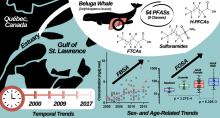| Title | Spatial and temporal trends in poly- and per-fluorinated compounds in the Laurentian Great Lakes Erie, Ontario and St. Clair. |
| Publication Type | Journal Article |
| Year of Publication | 2018 |
| Authors | Codling, G, Sturchio, NC, Rockne, KJ, Li, A, Peng, H, Tse, TJ, Jones, PD, Giesy, JP |
| Journal | Environ Pollut |
| Volume | 237 |
| Pagination | 396-405 |
| Date Published | 2018 Jun |
| ISSN | 1873-6424 |
| Keywords | Environmental Monitoring, Fluorocarbons, Great Lakes Region, Lakes, Ontario, Water Pollutants, Chemical, Water Pollution, Chemical |
| Abstract | The temporal and spatial trends in sediment of 22 poly- and perfluorinated (PFAS) compounds were investigated in the southern Great Lakes Erie and Ontario as well as Lake St. Clair. Surface concentrations measured by Ponar grab samples indicated a trend for greater concentrations near to urban sites. Mean concentrations ∑PFAS were 15.6, 18.2 and 19 ng g dm for Lakes St. Clair, Erie and Ontario, respectively. Perfluoro-n-butanoic acid (PFBA) and Perfluoro-n-hexanoic acid (PFHxA) were frequently determined in surface sediment and upper core samples indicating a shift in use patterns. Where PFBA was identified it was at relatively great concentrations typically >10 ng g dm. However as PFBA and PFHxA are less likely to bind to sediment they may be indicative of pore water concentrations Sedimentation rates between Lake Erie and Lake Ontario differ greatly with greater rates observed in Lake Erie. In Lake Ontario, in general concentrations of PFAS observed in core samples closely follow the increase in use along with an observable change due to regulation implementation in the 1970s for water protection. However some of the more water soluble PFAS were observed in deeper core layers than the time of production could account for, indicating potential diffusion within the sediment. Given the greater sedimentation rates in Lake Erie, it was hoped to observe in greater resolution changes since the mid-1990s. However, though some decrease was observed at some locations the results are not clear. Many cores in Lake Erie had clearly observable gas voids, indicative of gas ebullition activity due to biogenic production, there were also observable mussel beds that could indicate mixing by bioturbation of core layers. |
| DOI | 10.1016/j.envpol.2018.02.013 |
| Alternate Journal | Environ. Pollut. |
| PubMed ID | 29502002 |
Environmental Chemical Biology

